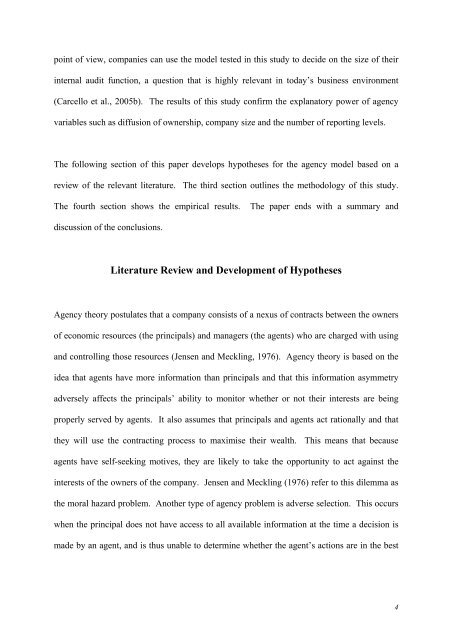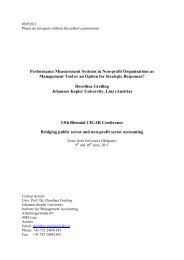WORKING PAPER - Faculteit Economie en Bedrijfskunde
WORKING PAPER - Faculteit Economie en Bedrijfskunde
WORKING PAPER - Faculteit Economie en Bedrijfskunde
You also want an ePaper? Increase the reach of your titles
YUMPU automatically turns print PDFs into web optimized ePapers that Google loves.
point of view, companies can use the model tested in this study to decide on the size of their<br />
internal audit function, a question that is highly relevant in today’s business <strong>en</strong>vironm<strong>en</strong>t<br />
(Carcello et al., 2005b). The results of this study confirm the explanatory power of ag<strong>en</strong>cy<br />
variables such as diffusion of ownership, company size and the number of reporting levels.<br />
The following section of this paper develops hypotheses for the ag<strong>en</strong>cy model based on a<br />
review of the relevant literature. The third section outlines the methodology of this study.<br />
The fourth section shows the empirical results. The paper <strong>en</strong>ds with a summary and<br />
discussion of the conclusions.<br />
Literature Review and Developm<strong>en</strong>t of Hypotheses<br />
Ag<strong>en</strong>cy theory postulates that a company consists of a nexus of contracts betwe<strong>en</strong> the owners<br />
of economic resources (the principals) and managers (the ag<strong>en</strong>ts) who are charged with using<br />
and controlling those resources (J<strong>en</strong>s<strong>en</strong> and Meckling, 1976). Ag<strong>en</strong>cy theory is based on the<br />
idea that ag<strong>en</strong>ts have more information than principals and that this information asymmetry<br />
adversely affects the principals’ ability to monitor whether or not their interests are being<br />
properly served by ag<strong>en</strong>ts. It also assumes that principals and ag<strong>en</strong>ts act rationally and that<br />
they will use the contracting process to maximise their wealth. This means that because<br />
ag<strong>en</strong>ts have self-seeking motives, they are likely to take the opportunity to act against the<br />
interests of the owners of the company. J<strong>en</strong>s<strong>en</strong> and Meckling (1976) refer to this dilemma as<br />
the moral hazard problem. Another type of ag<strong>en</strong>cy problem is adverse selection. This occurs<br />
wh<strong>en</strong> the principal does not have access to all available information at the time a decision is<br />
made by an ag<strong>en</strong>t, and is thus unable to determine whether the ag<strong>en</strong>t’s actions are in the best<br />
4
















